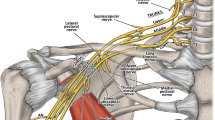Abstract
Abducens nerve palsy is a common clinical finding in neurology practice. In many instances, the origin is obvious and management straightforward; however, the list of possible etiologies and mimics is vast and diverse and diagnostic decisions can be challenging and even controversial. This is especially true when the abducens nerve is affected in isolation, since in the current era of cost-effective medicine, it is critical to accurately diagnose etiologies that may lead to major morbidity or mortality with efficiency. Topics for highlighted updates in this review include management of isolated abducens nerve palsy with a high likelihood of a microvascular ischemic etiology; common imaging pitfalls and current state-of-the-art neuroimaging; and abducens palsy mimics.

Similar content being viewed by others
References
Papers of particular interest, published recently, have been highlighted as: • Of importance •• Of major importance
Ambekar S, Sonig A, Nanda A. Dorello’s canal and Gruber’s ligament: historical perspective. J Neurol Surg B Skull Base. 2012;73:430–3. Interesting historical perspective on two anatomically critical structures.
Tubbs RS et al. Dorello canal revisited: an observation that potentially explains the frequency of abducens nerve injury after head injury. World Neurosurg. 2012;77:119–21.
Wysiadecki G, Orkisz S, Brzeziński P, Polguj M, Topol M. The abducens nerve: its topography and anatomical variations in intracranial course with clinical commentary. Folia Morphol. 2015;74:236–44.
Rucker CW. The causes of paralysis of the third, fourth and sixth cranial nerves. Am J Ophthalmol. 1966;61:1293–8.
Park U-C, Kim S-J, Hwang J-M, Yu YS. Clinical features and natural history of acquired third, fourth, and sixth cranial nerve palsy. Eye (Lond). 2008;22:691–6.
Rucker CW. Paralysis of the third, fourth and sixth cranial nerves. Am J Ophthalmol. 1958;46:787–94.
Rush JA, Younge BR. Paralysis of cranial nerves III, IV, and VI. Cause and prognosis in 1,000 cases. Arch Ophthalmol. 1981;99:76–9.
Patel SV, Mutyala S, Leske DA, Hodge DO, Holmes JM. Incidence, associations, and evaluation of sixth nerve palsy using a population-based method. Ophthalmology. 2004;111:369–75.
Shrader EC, Schlezinger NS. Neuro-ophthalmologic evaluation of abducens nerve paralysis. Arch Ophthalmol. 1960;63:84–91.
Robertson DM, Hines JD, Rucker CW. Acquired sixth-nerve paresis in children. Arch Ophthalmol. 1970;83:574–9. Chicago, Ill. 1960.
Keane JR. Bilateral involvement of a single cranial nerve: analysis of 578 cases. Neurology. 2005;65:950–2.
Lee MS, Galetta SL, Volpe NJ, Liu GT. Sixth nerve palsies in children. Pediatr Neurol. 1999;20:49–52.
Wilker SC, Rucker JC, Newman NJ, Biousse V, Tomsak RL. Pain in ischaemic ocular motor cranial nerve palsies. Br J Ophthalmol. 2009;93:1657–9. Retrospective study on the presence of pain in microvascular cranial nerve palsies.
Chapman PR, Shah R, Curé JK, Bag AK. Petrous apex lesions: pictorial review. AJR Am J Roentgenol. 2011;196:WS26–37. Quiz S40–3.
Bendszus M et al. MRI in isolated sixth nerve palsies. Neuroradiology. 2001;43:742–5.
Lee AG, Eggenberger E, Golnik K, Miller NR. MRI in isolated sixth nerve palsies. Neuroradiology. 2002;44:711–2. author reply 713–4.
Chi SL, Bhatti MT. The diagnostic dilemma of neuro-imaging in acute isolated sixth nerve palsy. Curr Opin Ophthalmol. 2009;20:423–9.
Chou KL et al. Acute ocular motor mononeuropathies: prospective study of the roles of neuroimaging and clinical assessment. J Neurol Sci. 2004;219:35–9.
Murchison AP, Gilbert ME, Savino PJ. Neuroimaging and acute ocular motor mononeuropathies: a prospective study. Arch Ophthalmol. 2011;129:301–5.
Tamhankar MA. Isolated third, fourth, and sixth cranial nerve palsies from presumed microvascular versus other causes: a prospective study. Ophthalmology. 2013;120:2264–9. A prospective analysis of the yield of neuroimaging in ocular motor mononeuropathies. Essential information on the risk of missing important neuroimaging findings or giant cell arteritis when diagnostic evaluation is not pursued in this setting.
Wang HZ, Simonson TM, Greco WR, Yuh WT. Brain MR imaging in the evaluation of chronic headache in patients without other neurologic symptoms. Acad Radiol. 2001;8:405–8.
Kontzialis M. High-resolution 3D magnetic resonance imaging of the sixth cranial nerve: anatomic and pathologic considerations by segment. J Neuroophthalmol. 2015;35:412–25. Up-to-date, state-of-the-art approach to imaging of all segments of the abducens nerve.
DeRespinis PA, Caputo AR, Wagner RS, Guo S. Duane’s retraction syndrome. Surv Ophthalmol. 1993;38:257–88.
Traboulsi EI. Congenital abnormalities of cranial nerve development: overview, molecular mechanisms, and further evidence of heterogeneity and complexity of syndromes with congenital limitation of eye movements. Trans Am Ophthalmol Soc. 2004;102:373–89. Excellent review of congenital cranial nerve dysinnervation disorders.
Kekunnaya R. Duane retraction syndrome: series of 441 cases. J Pediatr Ophthalmol Strabismus. 2012;49:164–9. Large retrospective series describing clinical features of Duane syndrome.
Griffin JF, Wray SH, Anderson DP. Misdiagnosis of spasm of the near reflex. Neurology. 1976;26:1018–20.
Goldstein JH, Schneekloth BB. Spasm of the near reflex: a spectrum of anomalies. Surv Ophthalmol. 1996;40:269–78.
Keane JR. Neuro-ophthalmic signs and symptoms of hysteria. Neurology. 1982;32:757–62.
Chan RVP, Trobe JD. Spasm of accommodation associated with closed head trauma. J Neuroophthalmol. 2002;22:15–7.
Dagi LR, Chrousos GA, Cogan DC. Spasm of the near reflex associated with organic disease. Am J Ophthalmol. 1987;103:582–5.
Moster ML, Hoenig EM. Spasm of the near reflex associated with metabolic encephalopathy. Neurology. 1989;39:150.
Author information
Authors and Affiliations
Corresponding author
Ethics declarations
Funding
No funding has been provided for this article.
Conflict of Interest
Christopher Elder, Clotilde Hainline, Laura J. Balcer, and Janet C. Rucker declare that they have no conflict of interest. Steven L. Galetta has received consultancy fees from Biogen.
Human and Animal Rights and Informed Consent
This article does not contain any studies with human or animal subjects performed by any of the authors.
Additional information
This article is part of the Topical collection on Neuro-Ophthalmology
Rights and permissions
About this article
Cite this article
Elder, C., Hainline, C., Galetta, S.L. et al. Isolated Abducens Nerve Palsy: Update on Evaluation and Diagnosis. Curr Neurol Neurosci Rep 16, 69 (2016). https://doi.org/10.1007/s11910-016-0671-4
Published:
DOI: https://doi.org/10.1007/s11910-016-0671-4




